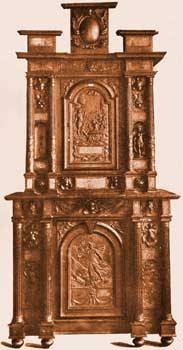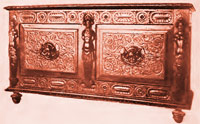French Furniture Styles
French furniture styles are renowned for their beauty and functionality all around the world, and their influence is evident in many other countries.
As far as the Medieval period, the Gothic architectural style originating in France influenced the furniture craftsmen who created solid oak pieces, which were either painted or heavily decorated with hand carvings. The motifs were those inspired by the Gothic cathedral ornamentation, mainly the pointed arch, the trefoil or the linen fold.
The Gothic-era French style furniture was largely functional, characterized by strength and durability. In the 14th century, the more luxurious furniture, previously found only in the ecclesiastical environment, entered the secular world.
By 1500, the Gothic style gave way to the Renaissance. Although some of the intricate designs of the previous era remained, the Italian influence became prominent. Under Francis I, the first Renaissance king of France, the furniture was mainly of Italian inspiration.

Cupboard Henry II
School of Du Cerceau
Under Henry II, craftsmen in France established their own schools, and modified the Italian models with the grace and truth of proportion characteristic of French taste. This resulted in the Henry II style, the first true, original French Renaissance style. It is also the first in a long series of French furniture styles named after the monarchs ruling the country.
The French Renaissance also produced the beginnings of a country-style furniture that is still popular today. It combines the “country” elements of rural life with the fancier design work found in urban homes.
After the Louis XIII Renaissance style, we enter the Baroque era corresponding to the long reign of Louis XIV. The Baroque introduced a majestic, royal style of décor. The French furniture was marked by dignity, grandeur, bold effects, round lines, and lavish but not excessive ornament, with symmetrical and balanced ornamental details. Heavy upholstery was both a decorative and a functional addition to the style of the time.
The Rocaille period or Rococo (1720 – 1755) introduced a more feminine sensibility. Like the Baroque style, Rococo furniture is known for its curvaceous outlines and extravagant decorations. However, Rococo furniture is lighter and avoids symmetry. It introduced progressively more delicate pieces, and craftsmen often hid secret compartments inside their work.
The simple lines of French provincial furniture became more popular in the mid-1700's as people began to enjoy rural yet cultured homes in areas like Bordeaux.
About 1750, the Louis XV style proper began, and the technique of curves attained a level never seen before. Towards the end of the period, the straight line started to reassert itself, and the motifs of ribbon knots, crowns, and garlands announced the future Louis XVI style.

French Renaissance Chest
Under the influence of Marie Antoinette, the Louis XVI furniture shows a return to simpler lines and more restrained and delicate ornament, with fine marquetry and painting.
In 1789 came the French Revolution and for a time the arts languished. During the Directory there was an attempt at reconstruction. Based on Roman and Pompeian elements, the Directory or, in French, Directoire style was an attempted return to the models of antiquity, but the style was sort of artificial, as it did not result from a natural transition.
The period of the Empire was the last of the great historic French furniture styles. The Empire style was based largely on the Imperial Roman, and it was cold, formal, and heavy. The pieces were not lavishly magnificent, like those of the Louis XIV period. However, despite being stiff and constrained, they had a certain dignity and grandeur, and were never trivially luxurious.
Furniture makers broke away from the rounded, flowing silhouettes of the previous French styles and began to make pieces in simpler forms, with straight lines and sharp edges. Once again, furniture was large and close to rectangular, but this time the craftsmanship was much more refined and the Greek and Roman influence was seen in the shape of the pieces.
In the years after the Restoration of the Bourbons, the First Empire style continued. Especially in cabinetry work, the 19th century shows a tendency of imitating the previous French furniture styles, with a combination of Gothic, Renaissance, Baroque, and Boulle work elements.
It wasn't until the late 1800's that a major change took place in the furniture design. The Art Nouveau period began in France, its name given by an art gallery of a German, S. Bing, who opened his “Maison de l’Art Nouveau” in 1895. Art Nouveau was a completely new, free-form style of decor that utilized natural shapes and minimalist sensibilities. Art, architecture, and interior decor all followed this pattern. Despite trying to completely disregard the previous styles and rely only on Nature as single source of inspiration, Gothic, Baroque, and Rococo motifs can still be identified during the Art Nouveau period.
Among the modern French furniture styles, the best-known is Art Deco, with its debut in the 1920’s. Symmetry and fluidity were its key points, and it utilized many of the forms from its forerunner, the Art Nouveau. Art Deco, as its title suggests, obscured the lines between art and functionality and encouraged utilitarian pieces that doubled as high art.
